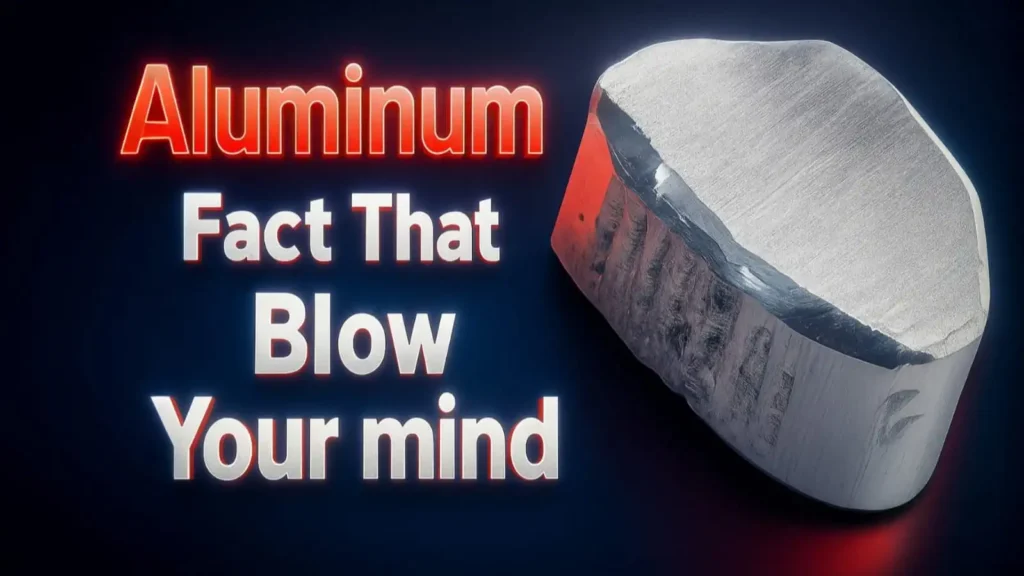
Hope you are fresh and fine, my brother/sister… Today we dive into a metal you touch many times each day. Maybe in a soda can. A phone body. A window frame. A car rim. Yet you may not really see it. After this guide you will. These amazing facts about aluminum will flip your view. Stay to the end. Fact #17 and #29 are real shockers.
What you will get in this article
- Introduction
- What Is Aluminum?
- Why Aluminum Feels “Everywhere”
- Core Properties (Fast Definition)
- Health & Safety Note
- Amazing Aluminum Facts (1 – 35)
- Daily Life Uses
- Aluminum Alloys Basics
- Aluminum Cans & Recycling Loop
- Aluminum In Building & Roofing
- Environmental Impact & Sustainability
- Future of Aluminum
- Conclusion
- FAQ
What Is Aluminum?
Aluminum (symbol Al) is a silvery, light metal element. Atomic number 13. It is the most common metal in Earth’s crust. It almost never sits pure in nature. It hides inside minerals like bauxite.
Simple Definition
Aluminum is a light, soft, rust‑resistant metal we refine from bauxite ore.
Why Aluminum Feels “Everywhere”
It shows up in transport, food packs, power lines, kitchen foil, phones, planes, and roofs. It is light. It resists corrosion. It conducts heat and electricity. It recycles with little loss. So industry loves it.
Core Properties (Fast Definition)
- Density: About one third of steel.
- Color: Silvery gray.
- Conducts: Heat and electricity well.
- Corrosion defense: A thin oxide skin forms fast. This stops deeper rust.
- Non magnetic: Useful near sensitive electronics.
- Soft but can be hardened: Add other elements to make strong alloys.
For further reading please visit.
- The Future Benefits of Agentic AI in Autonomous Systems
- Can You Shoot a Grenade? The Shocking Truth Behind This Explosive Myth Revealed!
- What is the Chicken Looking Dinosaur? Meet the “Chicken from Hell
- Ultimate Guide to the Best Summer Travel Destinations Across America
Health & Safety Note
Household use is safe. Do not store very salty or very acidic food long in plain foil pans. They can pit. Anodized cookware is tougher. Always recycle cans. Sharp cut edges can slice skin. Handle scrap with gloves.
Amazing Aluminum Facts (1 – 35)

Below each fact is short, plain value. Read, enjoy, share.
1. Light But Not Weak
Aluminum is about 2.7 g/cm³. Steel is ~7.8. That big drop slashes vehicle weight. Helps fuel savings.
2. Born From Stars
Heavy stars forged aluminum by nuclear fusion before they exploded. So each soda can holds star dust.
3. Once More Precious Than Gold
In the 1800s pure aluminum was rare. People displayed it like jewels. Price later crashed after new refining (Hall–Héroult process, 1886).
4. Napoleon’s Secret Dinner Metal
Stories say Emperor Napoleon III saved aluminum cutlery for VIP guests. Others got normal silver.
5. Capped the Washington Monument
In 1884 a small aluminum pyramid topped the monument. At that time it was a prestige metal.
6. Self‑Healing Skin
Expose fresh aluminum to air. A thin oxide layer forms in fractions of a second. It seals and blocks deeper corrosion.
7. Recyclable Forever
You can melt and reuse aluminum again and again. Very little quality loss.
8. Recycling Saves Big Energy
Recycling uses about 5% of the energy of making new (primary) metal from ore. Huge climate win.
9. One Can’s Speedy Loop
A used drink can can return as a fresh can body in almost 60 days or even less in efficient regions.
10. Airplane Backbone
Many aircraft frames are still mostly aluminum alloys. They balance weight, strength, formability.
11. Power Line Workhorse
Long distance electrical cables often use aluminum (sometimes with a steel core) due to low weight and good conductivity.
12. Hidden In Smartphones
Many phone shells or internal frames use precision aluminum alloys. Light helps grip. Metal aids heat flow.
13. Foil So Thin It Floats In Air Drafts
Kitchen foil may be as thin as 0.016 mm. A tiny breeze moves it like a leaf.
14. Anodizing Adds Color Without Paint
Anodizing thickens the oxide skin. Dyes soak in. You get bright, hard, colored metal with no peeling paint.
15. Space Grade Friend
Satellites and space hardware use aluminum parts for weight savings and heat control.
16. Key To Solar Panels Frames
Panel frames and mounting rails are often extruded aluminum. Light, stiff, corrosion resistant outdoors.
17. Bauxite Ore Looks Like Clay
Your shiny can traces back to a dull, earthy, red-brown ore. A visual shock when you first see raw bauxite.
18. Sparks In A Solid Rocket
Finely powdered aluminum serves as a fuel in solid rocket propellants. It boosts thrust energy.
19. Forms Glassy Spinel Under Heat
At very high temperature plus magnesium it can form spinel ceramics with special hardness.
20. Used In Water Treatment
Aluminum salts (like alum) help clarify water by clumping fine particles.
21. Kitchen “Cold Spot” Tester
Aluminum’s high thermal conductivity helps pans heat evenly and react fast to changes.
22. Non‑Magnetic Advantage
It stays non‑magnetic even when alloyed (mostly). Good near magnetic sensors and compasses.
23. Brilliant Reflector
Polished aluminum reflects light and heat. Used in LED housings, mirrors, telescope parts.
24. Helps Cool Electronics
Heat sinks and laptop bodies use it to move heat away from chips.
25. Strong In Alloys
Pure aluminum is soft. Add copper, magnesium, silicon, zinc, manganese. You get high strength 2000, 5000, 6000, 7000 series alloys.
26. Numbering System Tells Series
“6061” or “7075” are alloy codes. The first digit shows the main alloy family and key element.
27. Can Wall Is Crazy Thin
A can wall can be thinner than a human hair yet holds pressure due to shape and work-hardening.
28. Quietly Shields Radio Waves
Aluminum enclosures help block electromagnetic interference around circuits.
29. Powder Sparks Fireworks Brightness
Aluminum powder burns bright white. So many fireworks flashes are aluminum energy.
30. Helps Make Cars Safer And Greener
Light weight drops fuel use or boosts EV range. Crumple zones can be engineered in extrusions.
31. Roofing Reflects Heat
Aluminum roofing sheets reflect solar radiation. Helps keep buildings cooler.
32. Beer Taste Protected
Can’s inner thin polymer liner keeps metal from touching drink directly. Taste stays pure.
33. Ideal For Cold Chains
Light plus fast temperature shift control help in cold storage boxes and truck bodies.
34. Recycled Content Keeps Rising
Brands push higher recycled content in cans and building products to cut carbon footprint.
35. Future: Green (Low‑Carbon) Smelting
New tech uses inert anodes and renewable power to slash carbon emissions in primary production.
Daily Life Uses
You meet aluminum when you cook (foil, pans), snack (cans, pouches), travel (train bodies, plane wings), scroll (phone), work (laptop case), and relax (camping gear). Awareness builds smart recycling habits.
Aluminum Alloys Basics
Alloy = base aluminum + added elements. Each tweak shifts strength, formability, corrosion resistance.
Common Alloy Families (Simple List)
- 1000 Series: Almost pure. Great conductivity.
- 3000 Series: Manganese added. Beverage cans bodies.
- 5000 Series: Magnesium. Marine uses. Good corrosion resistance.
- 6000 Series: Magnesium + silicon. Versatile. Extrusions. Frames. 6061 famous.
- 7000 Series: Zinc + magnesium. Very strong. Aerospace, sports gear.
Heat Treat vs Non Heat Treat
Some alloys (like 2000, 6000, 7000) gain strength by heat treatment (solution + aging). Others (1000, 3000, 5000) strengthen by cold work.
Aluminum Cans & Recycling Loop
A can’s life: Bauxite → Alumina → Primary Aluminum → Can Sheet → Can → Use → Collection → Shred → Melt → Ingot → New Can. This loop can repeat many times. Each recycle saves energy, lowers mining impact, and cuts landfill waste. Always rinse and crush (if local rules allow) for space saving.
Fun Can Facts
- Tab and body use slightly different alloys.
- Bottom dome shape adds strength.
- One recycled can can power an LED TV for hours (energy saved vs new metal).
Aluminum In Building & Roofing
Aluminum frames, cladding panels, roofing sheets, gutters, and window systems cut weight and resist rust.
Aluminum For Roofing (Quick Guide)
Why choose it? Light, reflective, corrosion resistant, long life. Good for coastal zones when coated. Needs proper fasteners to avoid galvanic corrosion.
Basic Steps:
- Prepare roof deck dry and clean.
- Use underlayment for moisture barrier.
- Lay sheets with correct overlap (follow product guide).
- Fasten with compatible screws (often coated or stainless).
- Seal ridge and flashing.
- Inspect yearly for leaves, scratches.
Environmental Impact & Sustainability
Primary (new) aluminum makes CO₂ because smelters use lots of electricity. But switch to hydro, wind, or solar power plus inert anodes and emissions fall. Recycling slashes energy and emissions. Choose products with high recycled content. Support clean power smelting.
Future of Aluminum
Trends: lightweight EV parts, green smelting, higher recycled content, smart alloy design for 3D printing, nanostructured alloys, better coatings. These boost performance while lowering environmental impact.
Conclusion
Aluminum is light, star-born, once precious, forever recyclable, and part of your daily life. It saves energy. It powers planes. It frames solar panels. Now you know 35 cool facts. Share one with a friend today. And please recycle your next can.
Call To Action: If you loved these amazing facts about aluminum, drop a comment, share this article, and bookmark it. Want more mind-blowing material science facts? Check our Science & Nature section next.
FAQ
1. Is aluminum safe for cooking?
Yes. Normal cooking in quality pans or foil is safe. Avoid long storage of very acidic or salty food in plain foil.
2. Why recycle aluminum cans?
It saves up to about 95% of the energy vs making new metal. It cuts mining and landfill waste.
3. What makes aluminum rust resistant?
A thin, tight oxide film forms on contact with air. It blocks deeper oxidation.
4. How many times can aluminum be recycled?
Indefinitely in practice. Quality holds with good sorting.
5. Why is aluminum good for roofing?
It is light, reflects heat, and resists corrosion. This helps energy efficiency and long life.







